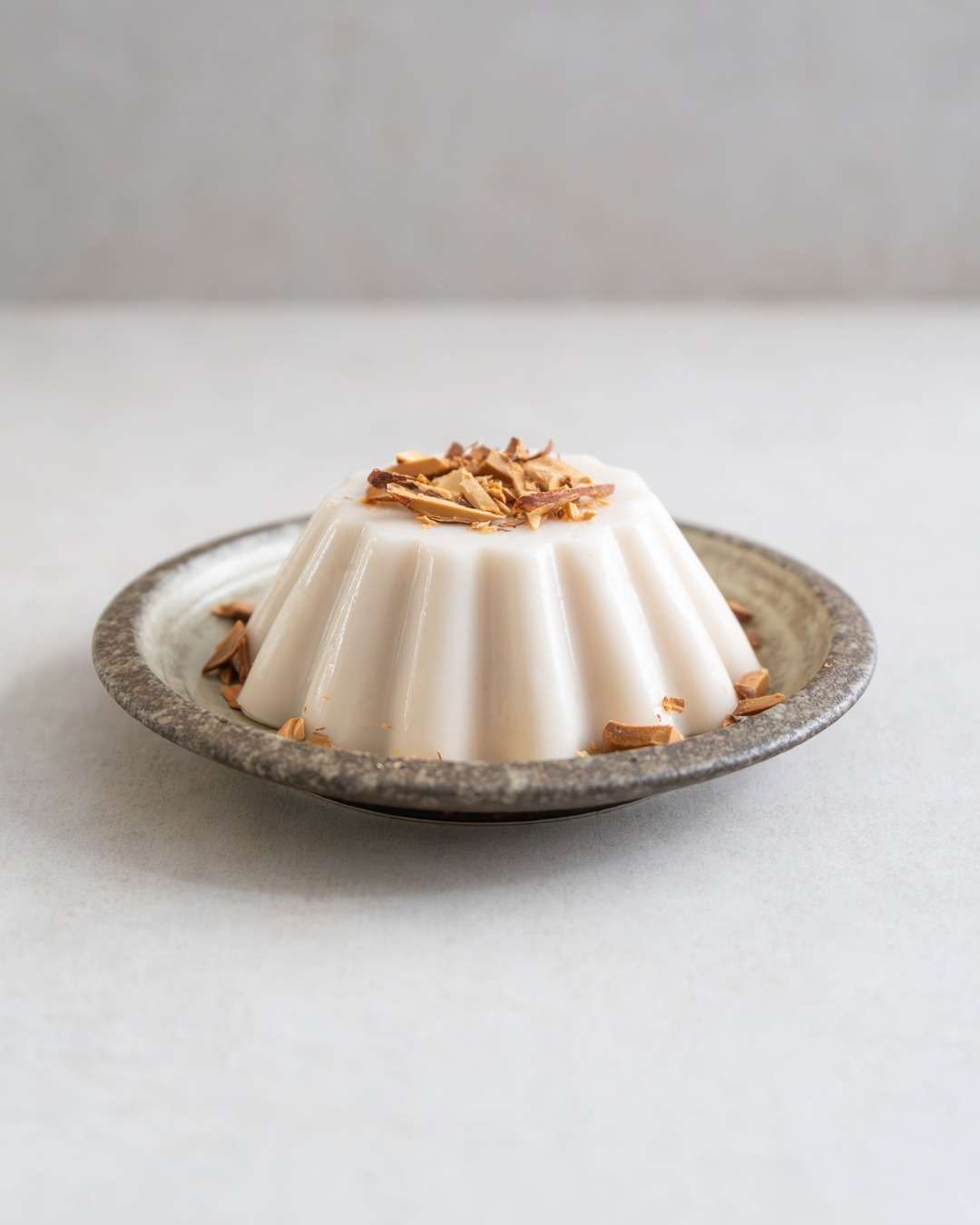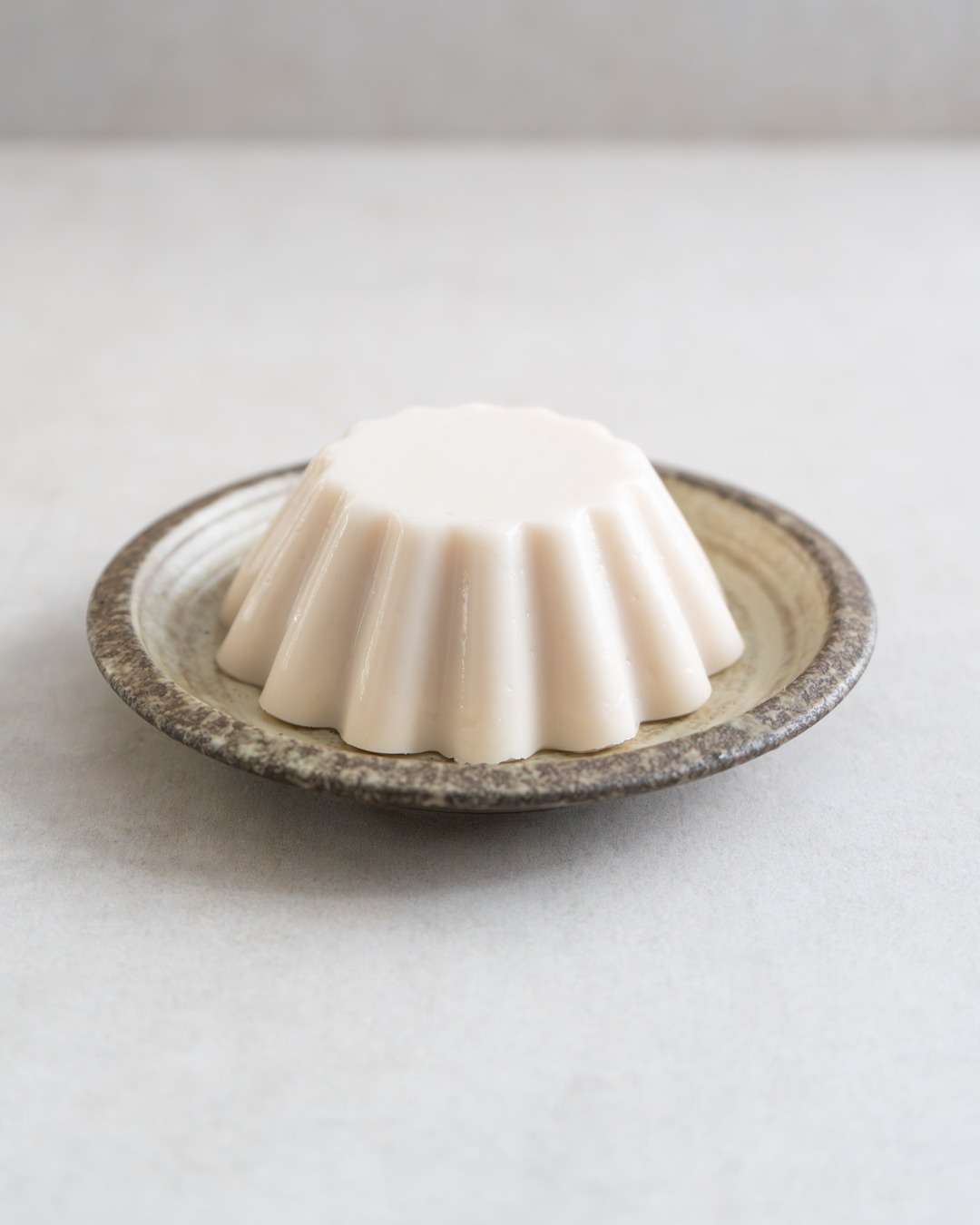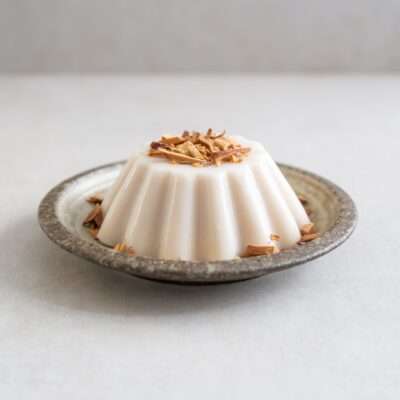Biancomangiare (Sicilian Almond Milk Pudding)

Using only a few key ingredients, Biancomangiare (translating to “eating white”) is a dessert of purity and elegance that shines a spotlight on one of Sicliy’s most prized treasures. Almonds.
Making the almond milk from scratch is surprisingly easy to do and will result in the freshest flavour. You can either dry the leftover almond pulp and grind it into flour, or use the pulp immediately for baking.
The method of using plant “milk” to create a creamy, traditionally vegan dessert can also be found in other cultures, for instance for the Puerto Rican Tembleque, a pudding made out of sweetened coconut milk.
Storage
You can store the finished pudding in the refrigerator for 2-3 days.

serves 4
Ingredients
Homemade Almond Milk (optional)
-
750ml water
Biancomangiare
-
500 ml almond milk
-
100g golden granulated sugar
-
50g cornstarch
-
1/4 tsp salt
-
1 organic unwaxed lemon
-
1 small cinnamon stick
-
a handful of almonds to serve (optional)
Method
If making your own almond milk, soak the almonds overnight. The next day, drain and rinse them. Add the almonds to a processor with the water and blend until smooth. Then drain them through a cheesecloth, squeezing out as much of the liquid as possible. You can use the leftover pulp for baking, for example in almond cookies. The almond milk can be stored in the fridge for 3-4 days.
To make the Biancomangiare, grab a small sauce pan and whisk the sugar, cornstarch, salt and 4 tbsp of the almond milk into a smooth slurry. Then whisk in the rest of the milk. Use a vegetable peeler to peel one strip of the lemon peel and add it to the pan along with the cinnamon stick. Slowly bring the liquid to a gentle boil over medium-low heat while stirring constantly to allow the lemon peel and cinnamon to infuse the liquid.
Once it begins to boil, remove the peel and cinnamon* and continue simmering the liquid until it begins to thicken. Now turn the heat to low and continue whisking for another 5 minutes. Turn off the stove and divide the mixture evenly over four bowls or moulds. Let it cool off slightly, then refrigerate it for a minimum of 1 hour to firm up.
If using, you can now roast the almonds to garnish the Biancomangiare. Pre-heat the oven to 180°C and, once hot, roast the almonds for 10 – 15 minutes, or until slightly golden when you cut one in half. Let them cool a little, then roughly chop them.
To serve, tip out the Biancomangiare and top it with some roasted almonds.
Storage: Refrigerate for 2-3 days
*You don’t need to discard the cinnamon stick. Just rinse it in water, then leave it to dry in a sunny spot. Scrape off a little of the outer layer and store it in a jar. You can use it this way up to 5 times before it loses its potency.
As an Amazon Associate I receive a small commission from affiliate links on this page.

Biancomangiare
Ingredients
Homemade Almond Milk (optional)
- 100 g raw almonds (skin on)
- 750 ml water
Biancomangiare
- 500 ml almond milk
- 100 g golden granulated sugar
- 50 g cornstarch
- 1/4 tsp salt
- 1 organic unwaxed lemon
- 1 small cinnamon stick
- a handful of almonds to serve (optional)
Instructions
- If making your own almond milk, soak the almonds overnight. The next day, drain and rinse them. Add the almonds to a processor with the water and blend until smooth. Then drain them through a cheesecloth, squeezing out as much of the liquid as possible. You can use the leftover pulp for baking, for example in almond cookies. The almond milk can be stored in the fridge for 3-4 days.
- To make the Biancomangiare, grab a small sauce pan and whisk the sugar, cornstarch, salt and 4 tbsp of the almond milk into a smooth slurry. Then whisk in the rest of the milk. Use a vegetable peeler to peel one strip of the lemon peel and add it to the pan along with the cinnamon stick. Slowly bring the liquid to a gentle boil over medium-low heat while stirring constantly to allow the lemon peel and cinnamon to infuse the liquid.
- Once it begins to boil, remove the peel and cinnamon* and continue simmering the liquid until it begins to thicken. Now turn the heat to low and continue whisking for another 5 minutes. Turn off the stove and divide the mixture evenly over four bowls or moulds. Let it cool off slightly, then refrigerate it for a minimum of 1 hour to firm up.
- If using, you can now roast the almonds to garnish the Biancomangiare. Pre-heat the oven to 180°C and, once hot, roast the almonds for 10 - 15 minutes, or until slightly golden when you cut one in half. Let them cool a little, then roughly chop them.
- To serve, tip out the Biancomangiare and top it with some roasted almonds.
Notes
*You don’t need to discard the cinnamon stick. Just rinse it in water, then leave it to dry in a sunny spot. Scrape off a little of the outer layer and store it in a jar. You can use it this way up to 5 times before it loses its potency.

I made this on a whim on a weekend because I was sick of eating the same mainstream desserts and it turned out exactly what I needed. Simple, quick and absolutely delicious ❤️
I don’t have the time to cook often and also don’t come across a lot of sites with good vegetarian and vegan options. However, I love your page and trying things you come up with.
I’m obsessed with this one in particular ❤️
Oh wonderful! I’m so glad you liked it ☺️
I made this, with homemade almond milk! Even though I followed the recipe to a T, it never set, even after 3 days in the fridge it was still a runny dessert. The taste was OK, but not something I would consider trying again!
I’m sorry to hear that! It should already begin to thicken into a thick paste in the pan that then sets as it cools down. You could try cooking it a little longer next time, but it sounds as if the starch didn’t really help binding the liquid at all. May I ask if you’ve used cornflour, by any chance? You can also try using potato starch next time and see if the result is better.
I lovethe look of this, I’ve got a lot of allergies but not to anything in this recipe!!!! Yay. However I can only find cornflour locally, is this the same as corn starch?
Cornstarch is not the same as cornflour. BUT… Confusingly, it’s cornstarch in the US and cornflour in the UK. So if you’re based in the UK, cornflour would be the right product to use. However, in the US cornflour is simply the corn ground into flour, while cornstarch is the extraction of the starches, which will set the pudding. Hope that makes sense! If in doubt, potato starch would be the best substitute.
One of my new favourite desserts! Super easy to make – especially if you use store-bought almond milk but I recommend trying it at least once with homemade almond milk. It’s truly worth the extra step, especially if you make a larger batch for the weekend. P.S. I know it says the roasted almonds are optional but they’re a must-have for me. 🙂
Wonderful! So nice to hear that you love it so much ☺️